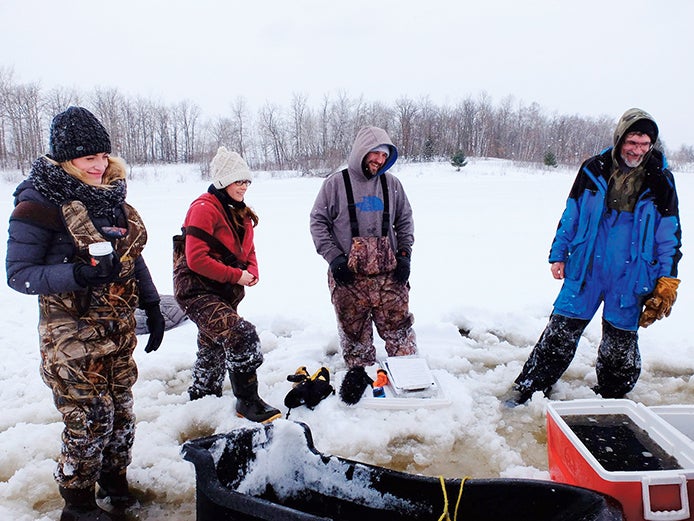Neither snow, slush nor sunken ice keeps these scientists from wetland restoration
Published 8:42 am Wednesday, February 20, 2019

- From left: Graduate student Breanna Keith, Minnesota Department of Natural Resources Wetland Research Group Leader Danelle Larson, Graduate student Jake Carleen and bait dealer Barry Thoele take a breather while stocking a wetland on Feb. 11, 2019, near Bemidji, Minn. Dan Gunderson | MPR News
By Dan Gunderson
MPR News/90.1 FM
It was a simple plan: Use a snowmobile to tow sleds loaded with coolers of amphipods onto a wetland in winter. Drill holes in the ice. Pour millions of the inch-long “freshwater shrimp” into the water. Kick-start the process of restoring a critical food source in the wetland.
But on a cold snowy day in February, the scientists’ snowmobile quickly bogged down in slush. The ice has started to sink under the heavy snow cover.
Wetlands researcher Danelle Larson stood on the shore, contemplating how to get the amphipods into the wetland: “We have 16 inches of water on top of the ice. Our snowmobile isn’t working.”
It’s one of the many challenges of stocking wetlands in the middle of winter. But winter is the time of year when those tiny invertebrates have the best chance of surviving a move. Amphipods are an important source of food for ducks — especially diving ducks — but they’re disappearing from wetlands across western Minnesota.
And while scientists are investigating why they’re disappearing, they’re also trying to restore the population of amphipods in wetlands where they once thrived.
“We need to reproduce this over many wetlands and across Minnesota to really get a good handle on it,” Larson, who works with the Minnesota Department of Natural Resources, said. She and her colleagues plan to study the amphipods they stock this winter for at least three years.
“It might just take some time for them to find mates and reproduce and really explode like we sometimes see in natural wetlands,” she said.
So, without the use of their snowmobile and despite a 19-degree temperature and a brisk wind, Larson and her crew hauled 14 coolers, one at a time, across about 100 yards of slush and ice.
They carefully transferred the amphipods into the wetland through a hole in the ice — scooped them out of the coolers with a plastic lemonade pitcher, then poured them into a bottomless bucket that they’d lowered into a hole in the ice. It was delicate work ensuring the tiny shrimp-like crustaceans weren’t exposed to the frigid air.
“They’re very sensitive to temperature, so we’ve got to be careful today to not expose them so they don’t freeze,” said Larson.
Despite the cold air and biting winds, the amphipods have a much better chance of survival if they’re transferred in the middle of winter than they would on a hot summer day when they are more active and need a lot more oxygen.
Larson’s amphipods were collected from a healthy wetland by bait dealer Barry Thoele. He stored them for a short time in temperature-controlled tanks of water and fed them organic potatoes until it was time to re-home them on this pond just outside Bemidji.
Thoele designed and built an underwater drone to sweep the bugs into a net under the ice. He said it’s the only one of it’s kind — and it’s what makes Larson’s project possible. It’s hard to catch amphipods in the summer when they live mostly in sediment and weeds near the bottom.
“Right now they’re moving to the surface of the ice because of the low-oxygen conditions in the ponds, which makes it easier for us,” said Thoele, who’s become an expert on stocking wetlands with amphipods. He’s been using the technique to help feed waterfowl in private ponds for more than 20 years.
“Most people, they look at these in the water and go, ‘Oh, it’s a bug.’ Well, yeah, but it’s an important bug,” said Thoele. “There’s a lot of things that depend on it.”
Many species of ducks depend on amphipods as a food source. Salamanders and fish also eat the shrimp-like invertebrates. They reside near the bottom of the food chain, so when they disappear, it causes a ripple effect that can affect the populations of other species. And they’re good harbingers of wetland health: Amphipods are sensitive to some environmental toxins and changes in water temperature or chemistry, so their health is a good indicator of the health of the wetland they’re in.
Thoele is now working with Larson and other scientists who want to know if the stocking technique can actually re-establish a sustainable amphipod population.
“We know that amphipods are important, just a critical food source for all sorts of wildlife especially ducks,” said Larson. “For some reason, they’re on the decline in Minnesota, in the Midwest, and we don’t understand why. But stocking might be a really neat restoration tool.”
It’s hard, physical work out on the slushy ice, dragging and dipping and dumping for hours — and hoping the more than 2 million amphipods take to their new home.
“Why are we doing this?” asks Thoele winded after dragging yet another loaded sled onto the wetland.
“It’s for the ducks, Barry!” replies fellow bait dealer David May, who is pouring gallon after gallon of amphipods through a hole in the ice.

